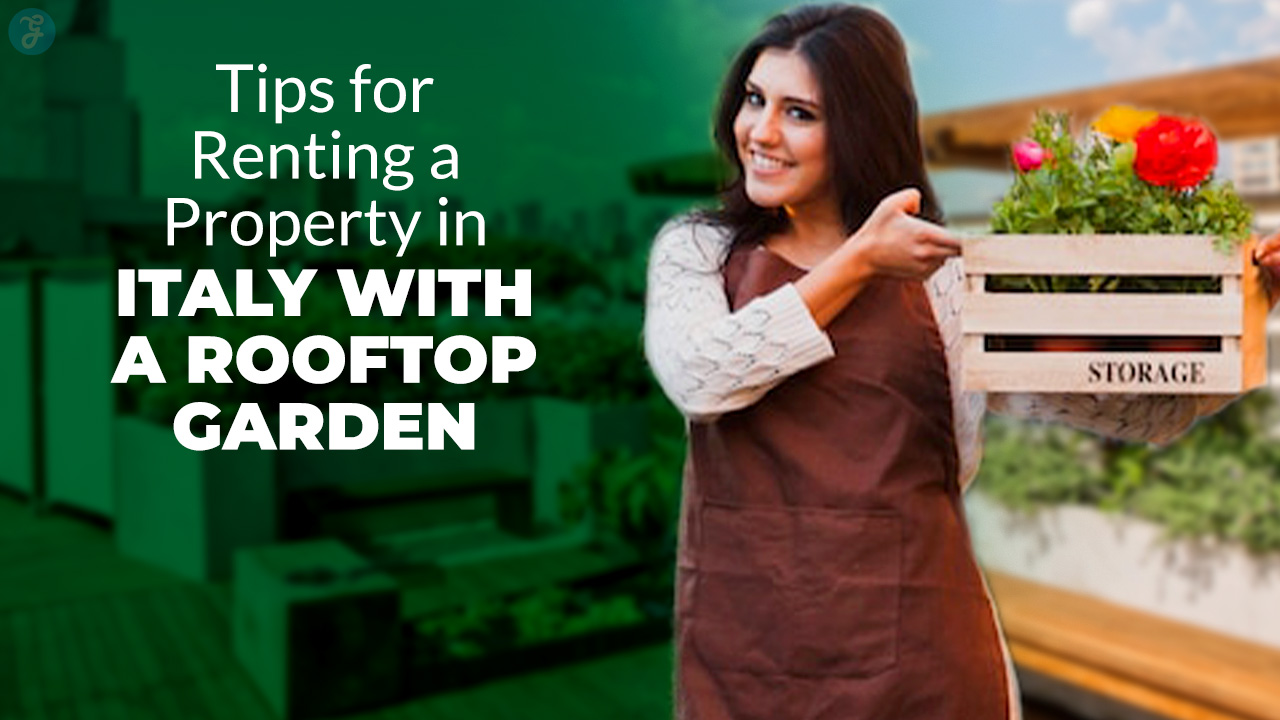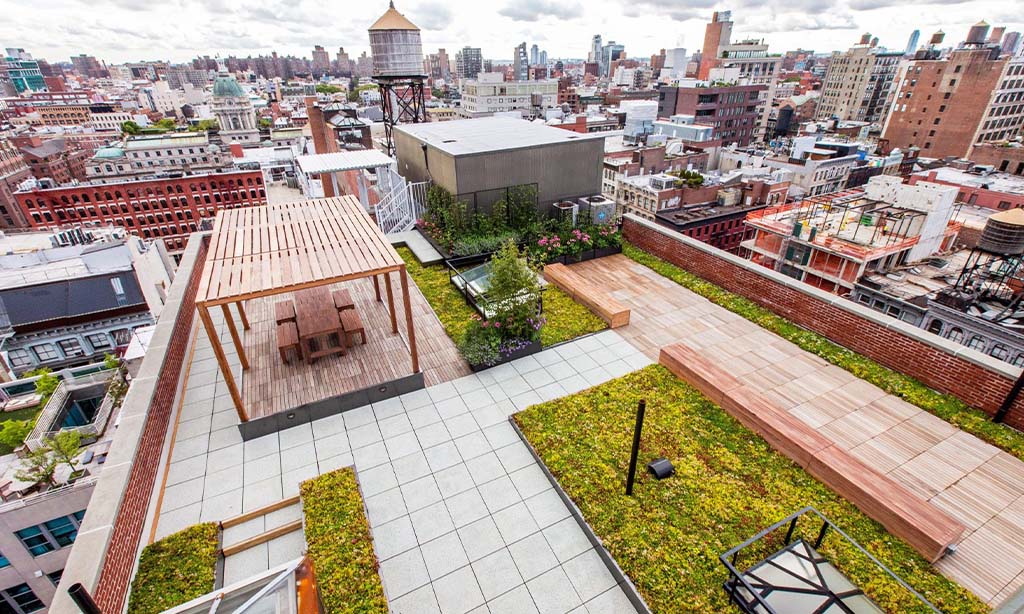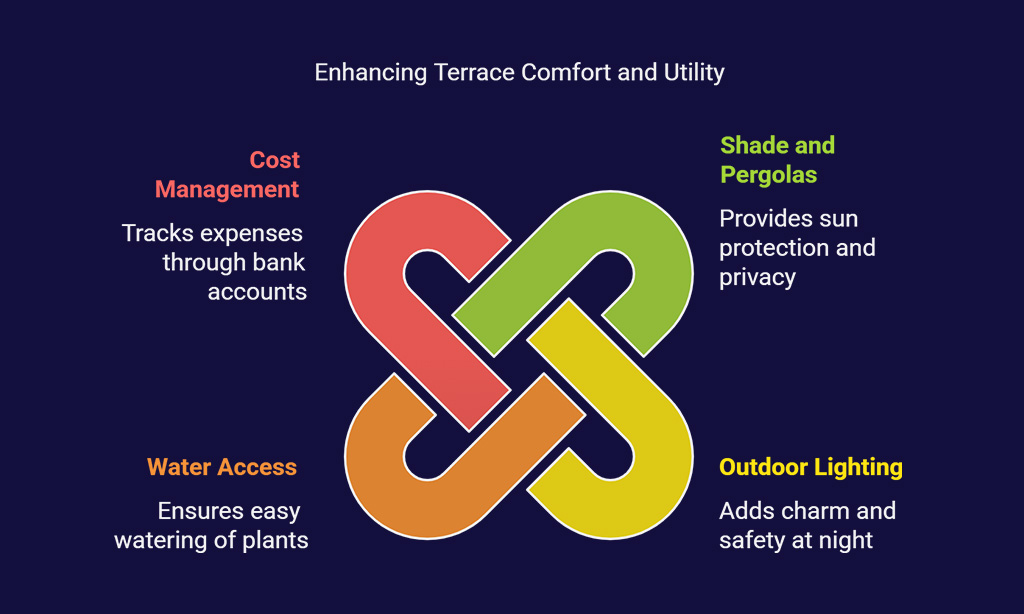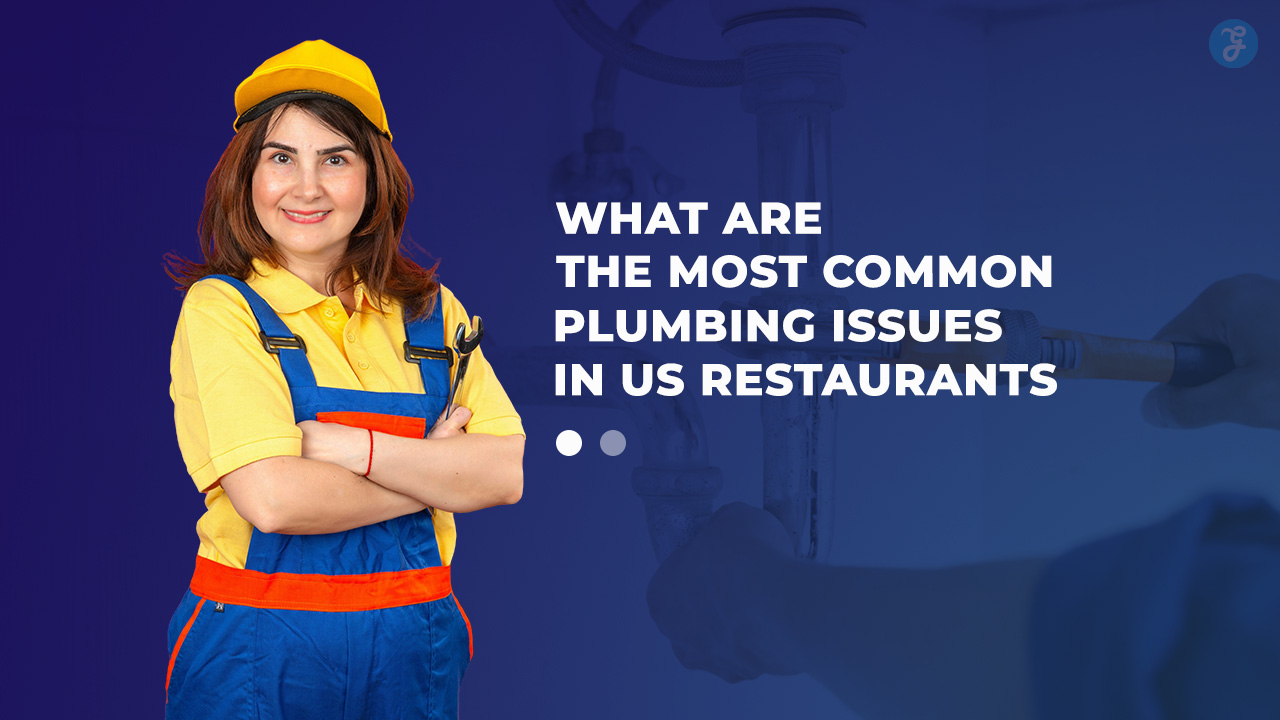Finding a rental property in Italy with a rooftop garden feels tricky for many tenants. Tenants often need an Italian bank account to pay rent by direct debit. Tips For Renting A Property In Italy With A Rooftop Garden shows how to check lease agreements, pick the right potting soil, and talk to landlords about service charges.
Read on.
Key Takeaways
- Review your lease for rooftop garden rules and costs. Article 1576 (Italian Civil Code) makes landlords pay for major roof repairs, while you handle pruning, watering, and soil. Set up rent and repair payments via an Italian bank account by direct debit.
- Test rooftop strength and leaks with a moisture gauge, sandbags, or a load‑bearing check. Italian law (2020) requires roofs to hold 150 kg per square meter. Inspect drains, vents, and stair access for hoses and planters.
- Design beds at least 2 ft deep by 2 ft wide. Slope decking 1/8 in per foot toward gutters or use PVC French drains. Use waterproof membranes and root barriers under raised beds.
- Budget €150–200 per month for potting soil, organic fertilizer, Vermiculite or Perlite, plus €50 for tools (trowel, pruning shears, gloves). Plan $200 per year for seasonal repairs, winter covers, and irrigation parts.
- Choose lightweight containers and drought‑tolerant plants such as lavender, rosemary, dwarf lemon, olive trees, and Cornus kousa. Add shade with a €150–300 wood pergola or €100 retractable awning, plus solar lights and a hose hookup for easy watering.
Understand the Rental Agreement
Treat the lease like a treasure map for your rooftop oasis; it may hide surprise fees or weird garden rules. Loop in your real estate agent and set up direct debits from your local bank account to cover rent, transfer tax, or extra premiums.
Review rooftop garden maintenance clauses
Open the rental agreement and scan the rooftop garden section. Article 1576 of the Civil Code states that landlords must handle roof repairs, beyond ordinary upkeep. Tenants pay for pruning, soil replenishment, and daily watering.
Landlords cover extraordinary costs like tile replacement, structural inspection, and gutter renewal.
Ask your real estate agent for a clause on rental property repairs and any fee caps. Check if the contract states a bank transfer or direct debits for repair bills. Use a spreadsheet or a contract model to track approved tasks.
Sign only after you clear upkeep terms, so you avoid surprise charges.
Check for restrictions on gardening or modifications
Landlords can ban planters or drilling in a rental property. Sell brokers or real estate agents hand over your rental agreement. Read each contract section on gardening or modifications.
Missing that detail can leave you stuck with a pile of heavy garden furniture and no home for it.
Install a waterproof membrane and root barrier only if the lease permits. Raised beds need good aeration and drainage to protect the tile. Seek a permit for paving stones or heavy outdoor furniture.
That small step saves a call to the condo board, or a fight with the seller later.
Inspect the Rooftop Garden
Grab a gauge and probe the dirt, then mark each damp patch to sniff out leaks hiding like mice in a pantry. Eye the slab’s weight capacity, imagine it as a stage that must hold pots and pals without toppling the show.
Evaluate the garden’s current condition
Use a moisture gauge to spot damp patches, they can rot pavers and joists. An aerial scan, or a simple load‑bearing test, highlights cracks in mortar under foot. Soil in one corner soaks up rain like a sponge, hiding weak spots under tiles.
Planter beds should measure two feet deep, two feet wide if you want shrubs or small trees. Tall plants work well on large terraces, they hide ugly views and boost privacy.
Check weight distribution by adding sandbags, watch the deck for lean or sag under stress. Realtors or a selling broker can share a structural report and garden designs before you sign rental property contracts.
Buy to let investors eye vacation rental spots carefully, they need solid decks and easy drainage. Set up an Italian bank account for deposits on water meters or hot water repairs.
Ask about mortgage in Italy rules or irpef fees if the roof space is mortgaged.
Assess structural safety and accessibility
Check load specs on rooftops. Italian law calls for 150 kg per square meter since 2020. A professional scans beams and decks with a tool like a level. Tenants also check stair widths and elevator doors.
They want trolleys and watering cans to fit. Rental property buyers often skip those checks.
Inspect soil beds near vents and drains. You need clear routes for hoses and heavy planters. Fit space-efficient furniture, like teak corner sofas or chaises, into corners. That trick frees up light and floor space.
You can clear 3‑foot paths for quick upkeep. Local officials in Rome and Milan log 30 percent of rooftop leaks on uneven access. Tenants link italian bank account deposits to repairs.
Ask selling brokers about past issues.
Clarify Responsibilities with the Landlord
Ask the landlord who waters the rooftop herbs and who patches the terrace tiles on your flat. Tie each duty to a lease clause, and pay your deposit with a local checking account so no one ducks a bill later.
Discuss gardening and maintenance responsibilities
Tenants tend the rooftop garden of a rental property, watering pots and trimming vines. They pay service charges for heating, cleaning and upkeep through an Italian bank account. Landlords handle structural repairs and major fixes.
Any early termination clause in a rental agreement is null and void.
Confirm who covers extraordinary expenses
Check the rental pact for a maintenance clause. Article 1576 of the Civil Code says landlords cover roof repair and major structure fixes. Small tasks like potting soil purchases and watering green space fall on the renter.
Map cost items in a rental checklist or budget table. List dates and limits, so you can track expenses through your Italian bank account. This step keeps your rental property plan clear.
Plan the Rooftop Garden Layout
Grab a tape measure, draw a simple blueprint, and mark drain lines. Test soil acidity with a pH meter and plan load zones on your drawing.
Consider space utilization for plants and furniture
Map planter spots with a measuring tape. Place containers close to the wall. Create sunny and shady zones for happier plants. Add windshields around taller plants and small trees. Fit a narrow bench by the railing.
Mix a potting table beside raised beds. Arrange a lemon tree in a corner. Calculate weight loads to avoid structural issues. Ask your landlord about rules in your rental property. Factor mortgage in Italy fees if you plan to buy later.
Ensure proper drainage and weight limits
Fit a drainage mat beneath wooden planter boxes built with lumber and beams. A French drain or PVC piping guides water off the roof. A structural engineer can help gauge load‑bearing capacity.
Rental property rules often limit weight on a terrace.
Slope decking at least 1/8 inch per foot toward a gutter. Test water flow after a downpour. Lightweight containers cut extra pounds. A load calculator app reveals if you top 50 pounds per square foot.
You can guard your security deposit with careful planning.
Choose Suitable Plants and Materials
Pick herbs like thyme and dwarf lemon that soak up sun all day. Pack garden scissors, a light container, and a soil blend, then keep reading for more container gardening tips.
Opt for lightweight planters and raised beds
Light planters weigh far less than ceramic pots. They shift around with ease. Box Gardening thrives on a thin sheet of waterproof membrane topped by root barriers. Gravel and upcycled paving stones fill gaps, give the roof a neat look.
Local garden sales often go on in spring. Make payments with your Italian bank account.
A moisture meter lets you spot dry spots fast. It works with a rainwater harvesting system or timer. This tool helps guard your rental property roof from overload. You avoid extra fees for damage.
Your landlord will smile.
Select plants suited to the Italian climate
Scout drought-tolerant species that handle hot sun. Lavender and rosemary thrive on little water. Tiny olive trees stay green year round and yield small fruit. Plant a Kousa dogwood (Cornus kousa) for white spring blooms and red fall leaves.
Add ground covers and annuals to fill gaps and feed soil.
Pay for pots and soil with your Italian bank account. A small weekly spend won’t dent your rental property budget or your mortgage in Italy plan. You can track each euro like you watch house prices or capital gains tax rules.
A moisture gauge and a soil pH tester stop waste, so you grow with ease.
Consider Utility and Comfort Features
Hang string lights or plug in a lamp to light up your terrace when dusk falls. Attach a hose to the wall tap or slip on a drip line to water your pots with zero fuss.
Add shade or pergolas for sun protection
Place a wood pergola over the seating area. Stretch solar shade cloth across the top. Plant bamboos, tall grasses, shrubs, or small trees at the base. They block harsh rays and act like privacy ninjas.
A wood kit costs €150 to €300 in Italy.
Link costs to your Italian bank account for easy tracking. Add a retractable awning for €100 more. You comply with your rental property contract. You need no mortgage in Italy or double tax treaty advice.
Include outdoor lighting and water access
Outdoor lights add charm and safety. Solar lamps or outdoor lamps plug in or charge by day. Timers switch them on at dusk. You can hang string bulbs above a dining spot, and watch them glow like fireflies.
They shine down softly, so friends linger under the sky. It brings life to your rental property after dark, and keeps bugs at bay.
A hose connection or an irrigation line keeps water close. A quick finger test or a sensor shows soil moisture. The mix of quality potting soil, slow‑release organic fertilizer and vermiculite helps roots thrive.
You monitor moisture often, since rooftops can hit 100°F in midsummer. Mind drainage and weight limits when you fill big pots. Log each bill in your italian bank account to track costs.
Such budgets suit a mortgage in italy plan or other expenses.
Budget for Maintenance and Upkeep
I keep a simple ledger to map my upkeep plan and curb surprise costs. I stash extra cash for quick fixes, so I don’t get tangled in rogue vine bills.
Allocate funds for gardening supplies
Set aside 150 to 200 Euros in your Italian bank account each month for potting materials and planters. Buy quality potting soil with slow-release organic fertilizer and Perlite or Vermiculite.
Combine gravel with mulched spaces and planters to boost drainage. Pick lightweight containers to respect weight limits on a rental property rooftop.
Assign 50 Euros for tools like a trowel, pruning shears, gloves, and a hose. Snap up a watering can that holds at least two liters. Head to a local nursery for deals on seeds and seedlings.
Nudge your budget for seasonal items early to avoid hidden fees.
Plan for seasonal upkeep or repairs
Spring calls for fresh pruning. Tenants use pruning shears to trim roots and manage growth in planter boxes. Carry a soil moisture meter to avoid overwatering during summer heat, save water and keep plants happy.
Autumn cleanup clears fallen leaves before frost can block drains. Winter storms test roof seals, so cover pots with cloth or plastic.
Check utility compliance for electricity and heating before cold months, and request documents from landlords to avoid last minute fixes. Renters of a rental property should set aside funds for new potting soil, fertilizer, and tool repair.
A basic irrigation system can cut water bills and save time. Budgeting about $200 a year covers supply costs and minor repairs.
Work with a Reputable Realtor
Scout a sharp property agent who knows neighborhood codes, and check out the Listing Inventory Service to find the best rooftop picks. Ask the sales office for a Price Comparison Report, so you can snag a deal with no ugly surprise fees.
Seek local expertise for property selection
Local agents know neighborhoods, legal quirks, rent trends. They speak Italian and read every clause in your rental pact. A real estate app or a listing on Idealista fails to flag garden rules fast.
Agents cut through fine print, set you straight.
Trips to offices in Milan or Rome bring quick answers. You meet a person who can tour three rooftop spots in one day. Ask a relocation agency to line up viewings, then watch your WhatsApp light up.
Use a translator app to smooth out language gaps.
Verify the property meets your rooftop garden needs
Inspect the terrace for a tap or drip irrigation point near the railing. Confirm it has a water seal layer under the tiles and clear drains to guide rainwater away. Verify that the support girders can carry at least 100 pounds per square foot.
Check your lease to see if the landlord supplies a water hose or if you must bring a watering tube. Note that unfurnished roofs may lack storage shelves for pots and soil or even a faucet.
Ask an engineer or agent to review your roof plan and access paths before you sign.
Takeaways
Renting a spot with a rooftop garden can lift your mood in busy cities. Review the lease agreement with care. Talk through who handles roof work and who pays. Sketch your layout with raised beds and good drainage.
Pick sturdy containers and a soil mix that breathes. Add shade sails, lights, and a water line. Budget for tools, a device, and regular upkeep. Call a local agent for help. You will enjoy a green retreat above the street.
FAQs
1. How do I find an Italian villa to rent with a rooftop garden?
Search local rental sites. Look for “rooftop terrace.” Ask an agent. Then book a visit. It feels like a treasure hunt above the streets.
2. Will I pay extra for a rooftop garden in my apartment?
Yes, landlords may add a fee for garden care. It covers water, plants, and cleaning. The fresh air is a fair trade.
3. Can I grow my own herbs on the roof terrace?
Yes, if your rent contract allows it. Talk to the landlord first. Use light pots and start with basil or mint. Your balcony may turn into a mini jungle.
4. What should I check before I sign the rent papers for the unit?
Check roof entry, guard rails, water tap, and sun hours. Look for tile cracks or small leaks, no one wants drips in their pasta. Ask the agent about repair rules.













































